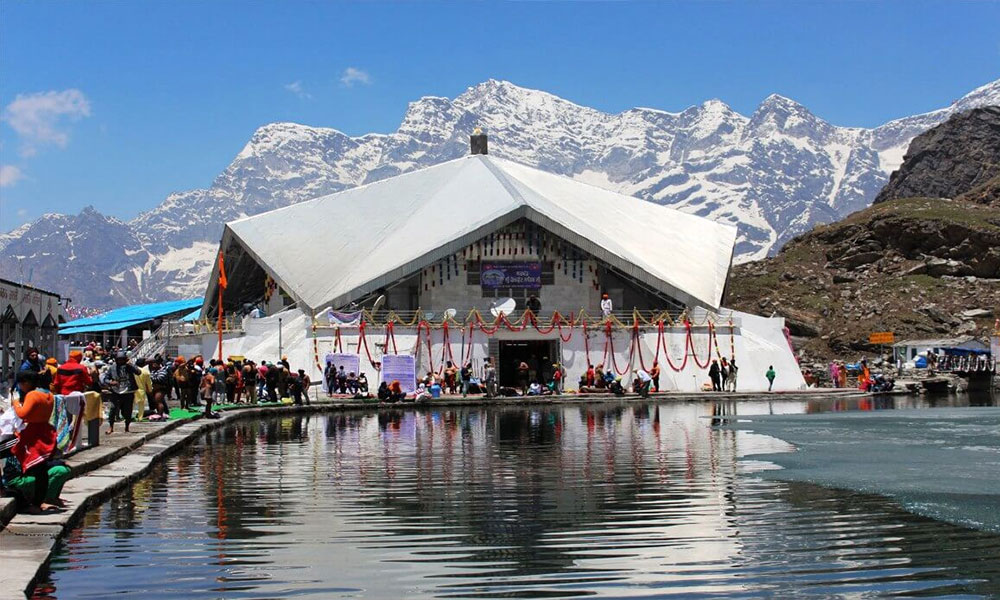For the Sikh community, only the blessed can make a visit to Hemkund Sahib gurdwara and bathe in the icy waters of the lake.
Located in the lap of the Himalayas at 4,572 m, Hemkund Sahib, in Uttaranchal, is one of the highest shrines in India. It is to the Sikh community what a trip to Hajis for Muslims. The trek to the mountain top is grueling. But after reaching the shrine, one feels truly blessed for having being given a chance to undertake the pilgrimage. The spot has a sense of calm and one does feel a sense of oneness with the Almighty.
Built around Guru Gobind Singh’s tapa-sthan (meditation spot), Hemkund Sahib gurdwara stands on the banks of a Sarovar (lake) surrounded by the saptsringa, or the range of seven peaks. For eight months of the year, Hemkund lake is inaccessible. With monsoon melting the snow, the rocky trail can be conquered between mid-June and the first week of October. This is the time when Sikhs arrive in large numbers to seek blessings and take a dip in the icy waters, which are supposed to have healing powers. According to local legend, even the gods bathe in the lake, giving the lake its other name, Brahm Kund, to signify purity. Hindus refer to the lake as Lokpal. The temple on its banks is dedicated to Lakshman who is said to have done penance here.
Jathas (pilgrim tours) leave for Hemkund Sahib from various gurdwaras in the country. With Rishikesh serving as the base, the trip usually takes around six days to be completed. The first leg of the expedition can be covered by a car. The drive is very scenic, with the river Ganga accompanying you all the way. The lower Himalayas, with their deep gorges, ravines, streams, and waterfalls, are extremely picturesque. Right through the journey, pilgrims busy themselves with prayers, kirtan (singing hymns), and Simran (meditation).
Passing through the towns of Devprayag, Rudraprayag, Srinagar, Pipalkoti, and Joshimath, you reach Gobind Ghat. Accommodation and langar (free food from the community kitchen) are available at gurdwaras on the way. From Gobind Ghat, the road divides into two; one goes to strong Badrinath, the other to Gobind Dham (3,048 m) and further ahead to Hemkund Sahib. The trek from Gobind Ghat must be completed as quickly as possible, as the terrain is through the steep and rocky forest. Nightfall sees a steep drop in temperature and you have only the stars for illumination. The 13-km trek can take anywhere between four and eight hours.
At any given point in time Gobind Dham is packed with pilgrims. Kiosks serving hot food do brisk business, while local porters try to strike a deal for the final leg of the journey to Hemkund the next morning.
The trail to Hemkund is not easy and may take as long as five hours. The greenery in the early part of the trek gives way to grey and brown patches of rocky terrain. You can stop at any of the wayside shacks to get your breath back or have a cup of piping- hot black-gram soup. From here onwards, chants of Wahe Guru rent the air as pilgrims feel rejuvenated enough to continue their journey. At the end of five hours when devotees spot Hemkund Sahib, they are overtaken by emotion. The gurudwara stands in all its glory by the side of the Sarovar. Many take a dip in the holy waters before entering the sacred portals of the shrine.
The pentagon-shaped gurdwara is designed like an inverted lotus. The roof can withstand the weight of heavy snowfall. There are doors on five sides to welcome visitors from every direction and faith. Whether it is the teenager or the 70-year- old woman, everyone is bound by a common faith.
FACT FILE
The Lord Calls
Discovering the Hemkund spot had been a quest for the Sikhs. In this respect, Sohan Singh, a retired granthi (head priest from the Indian Army and Modan Singh are synonymous with the legend of discovery. With the help of the Sikh community, they constructed a small gurdwara. The first jatha visited Hemkund Sahib in 1952. Inspiration for building a bigger gurdwara came in 1960 from Mata Ram Kaur, a housewife. The woman had a vision where the Guru asked her to do Kar Sewa (service). The management was convinced when she described details of Hemkund, a place she had never seen before.
Significance
“So immersed was I in the union of God, that I did not feel like descending from my abode to go down to the earthly world, as desired by the Lord.”
The abode that Guru Gobind Singh, the tenth and last guru of the Sikhs, refers to is Hemkund. It is the spot where he meditated for centuries and achieved oneness with God. Happy with his devotion, the Creator asked him to be born to earthly parents and aid a conflict-ridden society. These thoughts have been recorded in Bachittar Natak, the Guru’s autobiographical work.
